
REPORT: DECARBONISATION PATHWAYS FOR TRANSPORT
Do you remember George Jetson, the cartoon character that flew around with his family in their flying car? The Jetsons appeared on television in 1962, and the animation series was set in 2062. George Jetson was 40, so he is already among us, said keynote speaker Carlo van de Weijer, General Manager, Eindhoven AI Systems Institute at Eindhoven University of Technology. Yet, we don’t expect flying cars to become a reality any time soon. Neither do we expect teleportation, normal practice in sci-fi series Star Trek, to become part of our suite of transport modes.
What can we expect for the future then? And more importantly, how can we make sure that the energy demand and associated emissions from our most used modes of transportation and personal mobility stays within our available carbon budget? These were the guiding questions of the very well-attended ERC event DECARBONISATION PATHWAYS FOR TRANSPORT at Louwman Museum on 14 November.Frans Everts, President Directeur, Shell Nederland and Oscar Snijders, Partner, Sustainability Services Lead, Deloitte Netherlands, opened the event as hosting ERC partners. They were interviewed by moderator Sofie van den Enk who expertly led us through the entire programme. Frans and Oscar underscored the relevance of the 2024 ERC theme “Focus on demand.” There are alternatives for conventional fossil fuels available for road transport, shipping and aviation, but increasing demand for them is crucial.
Data doesn’t lie
“Do we hope for the best, or can we innovate ourselves out of trouble?” keynote speaker Carlo van de Weijer, General Manager, Eindhoven AI Systems Institute at Eindhoven University of Technology challenged participants. Carlo referred to trouble that we can expect, if we fail to act on decarbonisation of transport. “Data doesn’t lie. People buy more and travel further,” said Carlo. With current energy sources used for transportation, energy and CO2 emissions are directly linked. Carlo presented three potential solutions. The first: “Hope for the best”. We will use more energy and emit more CO2, but we hope we will be okay. It’s not an advisable way forward. The second is that we consume less, so we use less energy and emit less CO2. This could work in theory. However, history and data show that humans have a tendency for growth, not de-growth. Carlo puts his eggs in the last basket: innovation. Growth will happen, in all transport modes, and we will use more energy, but with less CO2 emissions.
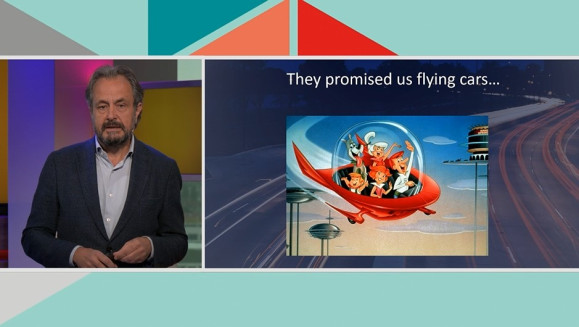
Carlo van de Weijer - The Jetsons
Infrastructure
Carlo asked participants how much of the solution they expect to come from reducing consumption, and how much from innovation. “I would add another option, infrastructure,” said László Varró, Vice President of Strategy, Insights & Scenarios, Shell International, who spoke after Carlo. He described how even after technological innovation has taken place, there is a chance that solutions cannot be deployed due to a lack of infrastructure. Another challenge lies in fragmented policy, which leads to uncertainty for the industry. “Dutch policymaking sometimes comes across as though The Netherlands is an island,” said László, “which doesn’t do justice to important transport hubs like Schiphol and the port of Rotterdam.” And European decarbonization policy is more ideological and, therefore, at times, impractical. “Focusing on effectiveness and keeping up with ongoing developments could be more pragmatic.”
Road transport
The Road transport session confirmed the need for the right regulatory framework and policy incentives to change demand. “Electric trucks are important,” said Sandra Geilings, Cluster Manager BeNeFrUx Commercial Road Transport, Shell, “but we need a mix of different solutions right now, because customers are in a different phase of transition. To support this, more flexibility of policies to include transition fuels sufficiently is needed.” Penalising diesel might do more for energy transition than favouring one low carbon solution over another, for example favouring EV over biodiesel.
There was agreement that most of the future fleet of trucks would be electric. That can have a bigger impact than just on transport. “Full electric cars and trucks can be part of the solution to balance the grid,” said Frank Verhoeven, CEO of Vos Logistics. “If all cars and trucks are equipped with bidirectional charging, their batteries can be part of the solution to the challenge of electrification of households, industry and transport all at once.”
Petrouschka Werther, Director Sustainable Mobility, Ministry of Infrastructure & Water Management, agreed with the expectation, arguing that one of the bottlenecks to resolve will be double taxation. As a policymaker among transport industry representatives, she was pleased with the feedback from industry. “I have worked on policy making for over twenty years,” Petrouschka said, “and I keep on it to further improve policy. Developments are going so fast, and policymakers need to support that.” She agreed with László’s call for pragmatism. “The worst thing for companies,” said Petrouschka, “is that companies want to change, but can’t because of factors outside of their control.”
Jurgen de Theije, Program Director Zero Emission, DAF Trucks is committed to helping the transport sector decarbonise. DAF manufactures and sells electric trucks. “The technology for zero-emissions trucks is there,” said Jurgen. “But these trucks have no use without sufficient charging or refuelling stations or too few clients willing or able to invest.” Jurgen made a case for policies to be more holistic and to support different options to transition. OEMs like DAF are held accountable for the tailpipe emissions of the trucks. This doesn’t sufficiently support the use of more renewable diesel whilst not all trucks are electric yet.
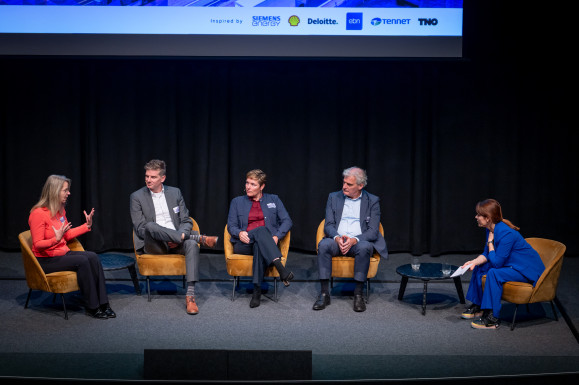
Road transport session
Shipping
Deep-sea shipping needs vast amounts of energy, and for decades, ships have used the cheapest oil available. The low-carbon fuels that shipowners need to switch to are much more expensive. All panellists see willingness and initiatives in the industry for change but not yet at sufficient scale. Given that shipping is a global industry and climate change is a global problem, only regulations with international reach can have an impact. Regional or national regulations can only impact shipping that takes place within that geography.
The International Maritime Organization (IMO), a UN agency, is best positioned to lead and has developed a strategy to reduce international maritime emissions reductions. More clarity on how this strategy can be implemented is expected this year.
“One of the issues with maritime emissions reductions is that CO2 in international waters is not counted and responsibilities become blurred,” said Johan Svendsen, Head of Program - Catalyze Ecosystem Transition at Mærsk Mc-Kinney Møller Center for Zero Carbon Shipping. “That is why we need international standardisation in regulations and pricing mechanisms globally to support decarbonisation.”
“Shipping is an international industry with a long chain of players and stakeholders,” Martine Hoeksma, Head of Unit Sustainable Shipping, Ministry of Infrastructure & Water Management added. “To reduce shipping emissions, ensure a level playing field, and have a healthy and sustainable shipping sector in the future, we need to collaborate throughout the chain and actively bring stakeholders together.”
This is exactly what Johan does with his work on so-called green corridors projects, to connect stakeholders along a chain, for example for mining. The projects are designed to demonstrate what is possible, what is needed and what the incremental costs and cost differences are of low or zero carbon alternatives. Based on that, the Center for Zero Carbon Shipping advises on what policy can look like to achieve the desired results. Ports play an important role in creating new value chains.
Another key question in the shipping session was how to bridge the price gap and how to build a viable business case for low-carbon shipping. “EU ETS revenues originating in the maritime industry could flow back to the industry to accelerate maritime emissions reductions,” said Nick Lurkin, Senior Adviser Climate & Environmental Affairs, KVNR (Royal Association of Netherlands Shipowners), “for example by narrowing the price gap between more expensive zero-carbon fuels and conventional fuels.”
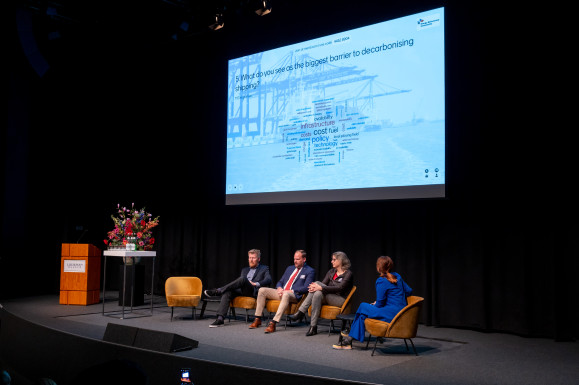
Shipping session
Aviation
Of the three transport modes discussed, aviation is the most difficult to decarbonise. However, like in transport and shipping there are first movers that pave the way, stimulate new regulations and try to activate consumer demand. Bregje Drion, SAF Sustainability Manager at KLM Royal Dutch Airlines states, that for transition in aviation we need affordability and availability of alternative solutions. “Biobased SAF is 3-4 times more expensive than traditional fuels and synthetic fuels are even 5-8 times more costly. Volumes of biobased fuels are limited because they must come from sources that can demonstrate non-competition with food or impact biodiversity.”
Although the market share of SAF (Sustainable Aviation Fuels) is still low and the costs are high, there is demonstrable consumer demand, from individual passengers and corporate and cargo customers. Neste is a pioneer in biobased SAF. “We are continuously looking for new biofuel feedstock,” said Jörg Hübeler, Head of Market Development Transportation & Industry at Neste. “We will keep investing in new production. In regions where production is not possible, we can use book-and-claim. The goal is to reduce emissions from aviation, it doesn’t matter where they take place. Regulations are currently not keeping pace with the demand.”
Like harbours / ports for shipping, airports can play an important role in making aviation more sustainable.
“Airports usually offer only one fuel. Changing this could make a difference for an airport’s sustainability performance,” said Victor Rijkaart, Project Leader Business Development, Quartermaster Flying Vision, Delft University of Technology.
When thinking about decarbonisation solutions, people often think about how the energy consuming equipment should change. As for heavy road transport and shipping, changing the aircraft is the easier thing to do compared to all other steps. “There are multiple routes to decarbonise aviation,” said Adriaan Leyte, Vice President, Fokker Technologies Holding B.V./ GKN Aerospace, “and each comes with its own challenges. The fact that aviation is an international business, adds to the complexity of the puzzle.” Improved efficiency and SAF have the greatest potential for short to medium-term decarbonisation, but Fokker is also developing an aircraft that can burn liquid hydrogen and is looking at battery electric propulsion.
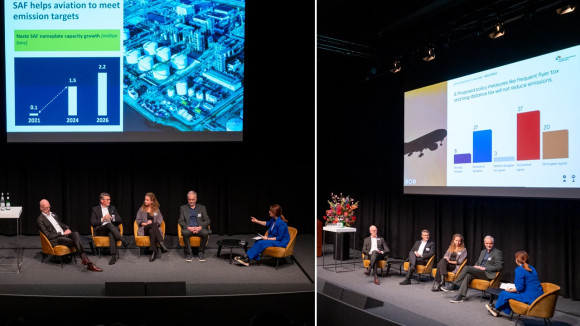
Aviation session
Behavioural changes
The last plenary session was a debate on the role of behaviour. Two teams dubbed the Humpbacks, after the sea animals that travel farthest, and the Reindeers, after the land animals that travel farthest, tried to convince each other and the audience.
Maarten Kroesen, Associate Professor, Delft University of Technology and Abigail Koch, Senior Consultant, Sustainable mobility, Deloitte made up team Humpbacks and Hugo Houppermans, Director, Coalitie Anders Reizen (Travelling Differently Coalition) and Tiago Neves, Public Relations Manager, TU Delft Energy Club were team Reindeers.
The first statement was that “Innovation is NOT the solution to decarbonise personal mobility” and the Reindeers disagreed with that. “The goal of technology has always been to improve the status quo and to solve the humanities problems. If we can bring sustainability to the main spotlight, as a problem humanity must solve, technology will fix it. Technology must work as a catalyst to change human behaviour.” The Humpbacks agreed with the statement. “Technological innovation is only a piece in the chain of things that must happen to choose sustainable mobility. Even if you have an alternative, you still have to make a conscious decision to use it.”
The second statement was “To change people’s behaviour effectively, companies need to take the lead.” The Reindeers agreed with the statement. “Fifty percent of the time, people travel because their employer asks for it, so companies have a leading role in the transition. Companies can make the default choice the sustainable choice.” But the Humpbacks were not convinced. “Large companies can and should take action, but in the end, employers follow the rules set by the government. For example, many employers still provide company cars, even though we know this increases the demand for car travel at the expense of more sustainable forms of travel. Companies are not to ‘blame’ for this; the current fiscal policies allow them to provide these benefits.”
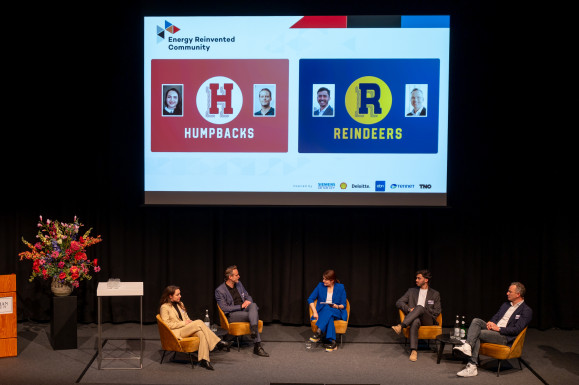
Behaviour session
We need you!
The popular vote was too close to call the winning team with the most convincing arguments. It was clear that neither innovation nor behaviour alone can lead to the desired transport decarbonisation. Regardless, it is good to remember Carlo van de Weijer’s words at the start “if we fail to act now to decarbonise energy demand for growing transport demand, our problems will have doubled by 2050. You are in a position to influence this. Cross-industry and cross-border. So, we need, YOU to innovate ourselves out of trouble. Thank you in advance for that!”
The ERC Steering Committee thanks all involved in making the event a success and looks forward to connecting with you again in 2025!





